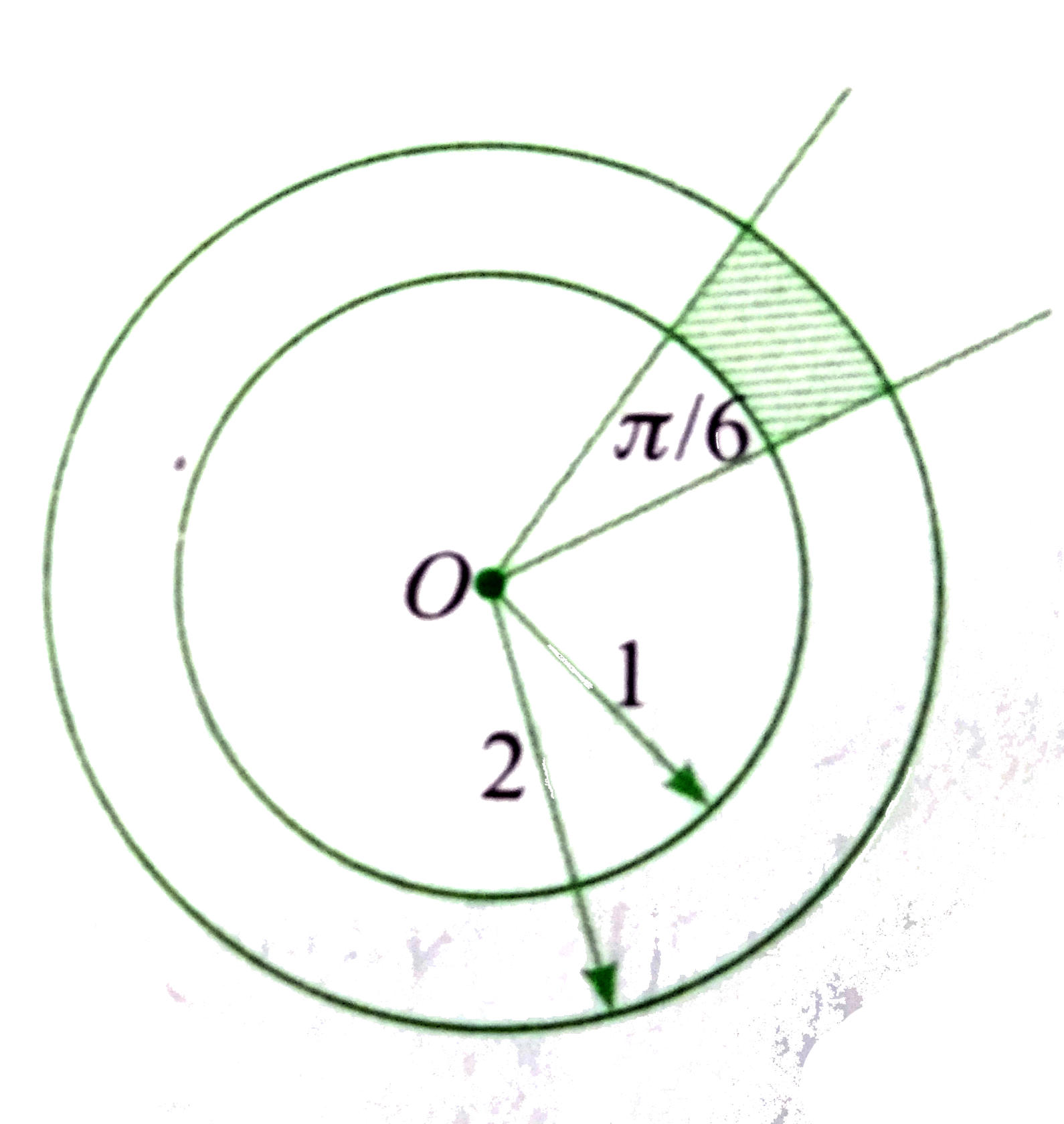The area bounded by the circles x2+y2=1,x2+y2=4, and the pair of lines √3(x2+y2)=4xy is equal to π2 (b) 5π2 (c) 3π (d) π4Solution in Bengali
π/2
5π/2
3π
π/4
The correct Answer is:4
The angle θ between the lines represented by
√3x2−4xy+√3y2=0 is given by
θ=tan−1.√h2−ab|a+b|
=tan−1.2√22−3√3+√3=π6
Hence, the shaded area is
π/62π×π(22−12)=π4

Topper's Solved these Questions
- BOOK - CENGAGE PUBLICATIONCHAPTER - CIRCLE EXERCISE - Multiple Correct Anser Type29videos
CIRCLE
- BOOK - CENGAGE PUBLICATIONCHAPTER - CIRCLE EXERCISE - Linked Comprehension Type (For Problem 1-3)3videos
CIRCLE
- BOOK - CENGAGE PUBLICATIONCHAPTER - CIRCLE EXERCISE - CONCEPT APPLICATION EXERCISE 4.172videos
CIRCLE
- BOOK - CENGAGE PUBLICATIONCHAPTER - BINOMIAL THEOREMEXERCISE - Comprehension11videos
BINOMIAL THEOREM
- BOOK - CENGAGE PUBLICATIONCHAPTER - CIRCLESEXERCISE - Comprehension Type8videos
CIRCLES
Similar Questions
about to only mathematics
02:14View SolutionEach side of a square is of length 6 units and the centre of the square Is ( - 1, 2). One of its diagonals is parallel to x+y=0. Find the co-ordinates of the vertices of the square.
05:40View SolutionThree concentric circles of which the biggest is x2+y2=1, have their radii in A.P If the line y=x+1 cuts all the circles in real and distinct points. The interval in which the common difference of the A.P will lie is:
01:36View SolutionConsider a G.P. with first term (1+x)n, |x|<1, common ratio 1+x2 and number of terms (n+1). Let 'S' be sum of all the terms of the G.P., then
The coefficient of xn is 'S' is03:19View Solution
In the diagram as shown, a circle is drawn with centre C(1,1) and radius 1 and a line L. The line L is tangent to the circle at Q. Further L meets the y-axis at R and the x-axis at P in such a way that the angle OPQ equals θ where 0<θ<π2.
Coordinate of Q is04:26View SolutionArea lying in the first quadrant and bounded by the circle x2+y2=4 and the lines x=0andx=2 is
(A) π (B) π2 (C) π3 (D) π406:07View SolutionSmaller area enclosed by the circle x2+y2=4and the line x+y=2is
(A) 2(π−2) (B) π−2 (C) 2π−1 (D) 2(π+2)13:45View Solutiontan−1(xy)−tan−1(x−yx+y) is (A) π2 (B) π3 (C) π4 (D) π4 or 3π4
04:31View SolutionThe area of the region described by A={(x,y):x2+y2≤1 and y2≤1−x} is (A) π2+43 (B) π2−43 (C) π2−23 (D) π2+23
07:35View SolutionThe area bounded by the curves y=x^(2) and y=(2)/((1+x^(2))) is (pi-(2)/(3)) sq.unit (B)(pi+(2)/(3)) sq.unit (C) (pi+(4)/(3)) sq.unit (D) none of these
04:00View SolutionThe area bounded by the curves x^(2)+y^(2)=1,x^(2)+y^(2)=4 and the pair of lines sqrt(3)x^(2)+sqrt(3)y^(2)=4xy ,in the first quadrant is (1)(pi)/(2)(2)(pi)/(6)(3)(pi)/(4)(4)(pi)/(3)
10:11View SolutionLet y=y(x) be the solution of the differential equation, dydx+ytanx=2x+x2tanx,x∈(−π2,π2), such that y(0)= 1. Then (a) y'(π4)−y'(−π4)=π−√2 (b) y'(π4)+y'(−π4)=−√2 (c) y(π4)+y(−π4)=−π22+2. (d) y(π4)−y(−π4)=√2
01:48View SolutionIf dydx+y sec x=tan x," then (√2+1)y(π4) - y(0)=, (A) √2 - π4 (B) √2 + π4 (C) √2-π2(D) √2+π2
View SolutionThe triangular region bounded the tangent at the point P(π4) on the hyperbola x29−y24=1 and the pair of lines (y2+x3) (y2−x3)=0
01:26View SolutionThe area bounded by the curves x2+y2=1,x2+y2=4 and the pair of lines √3x2+√3y2=4xy, in the first quadrant is (1) π2 (2) π6 (3) π4 (4) π3
03:48View SolutionArea lying in the first quadrant and bounded by the circle x2+y2=4
the line x=√3y and x-axis , is
(a) π2
(b) π4
(c) π3
(d) π02:06View Solution

